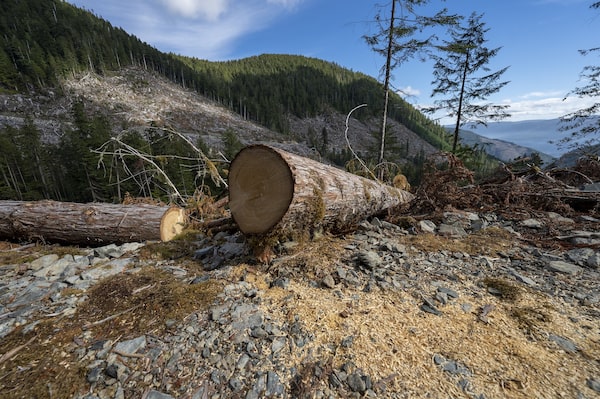
Fresh sawdust is seen from a tree cut near near Port Renfrew, B.C. on Oct. 4.JONATHAN HAYWARD/The Canadian Press
British Columbia’s New Democratic Party government announced a reforestation milestone this week, with one billion new trees planted since taking power.
Since 2018, the first planting season after the NDP formed government, the province has ramped up its tree-planting program, replacing forests that have been logged, lost to wildfires, or destroyed by mountain pine beetle infestation.
Now the province wants to expand its program to book carbon credits for the effort – a climate-action accounting tactic that has been widely criticized by environmentalists.
B.C. Environment Minister George Heyman says the 300 million seedlings planted this year will increase the carbon-capture capacity of the province’s forests and reduce emissions over the long term. Heading into this month’s COP26 summit on climate, his assignment was to explore opportunities to partner with the federal government to plant more trees as a way to restore lands that absorb more carbon than they emit into the atmosphere.
At the same time, the province wants to widen the scope of its BC Forest Carbon Offset Protocol to expand access to its carbon-offset market so that more Indigenous communities and forest companies can turn reforestation and better forest-management activities into marketable carbon credits.
B.C. doesn’t count the carbon removed from the atmosphere from forest management projects in its main inventory of greenhouse gas (GHG) emissions. Since 2007, B.C.’s GHG tally has increased by five per cent – despite more than a decade of policy changes designed to reduce emissions.
It does, however, keep a separate set of books on GHG emissions that includes credit for tree planting. By that accounting, the province’s GHGs have increased by only two per cent. That looks better, but only because the province does not include the GHG emissions caused by wildfires in its inventory.
Canada has a rich store of natural carbon sinks, which take up some of the carbon dioxide emitted by burning fossil fuels. B.C.’s old-growth forests make up an important part of that picture, but the climate benefits are lost when those forests and other landscape features are disrupted.
“We’re losing our forest carbon stores in places like B.C. as a result of fires, clear-cut logging, and the other impacts of climate change,” said Shane Moffatt, head of Greenpeace Canada’s nature and food campaign. If B.C. accounted for the GHGs released into the atmosphere as a result of wildfires, the picture changes substantially: B.C.’s forests become net emitters of carbon dioxide.
More importantly, he said, the trade in forest carbon offsets is being used as cover to allow polluters to continue pushing the planet closer to a climate catastrophe.
“The scientific case for using forests as an excuse to keep pumping out greenhouse gas emissions would be a disaster for Canada’s climate ambitions, and is no solution to global biodiversity loss,” Mr. Moffatt said in an interview. “Many of the biggest polluters are trying to distract attention from the need to reduce emissions [through] how to offset them with a global carbon market. It is the last thing we need right now.”
Canada’s new federal Environment Minister, Steven Guilbeault, was arrested in 2001 during a protest against the notion that Canada could receive credits for its management of carbon sinks such as forests that absorb carbon dioxide. He compared it at the time to being rewarded “for watching trees grow.”
His B.C. counterpart, Mr. Heyman, sat down with Mr. Guilbeault during COP26 in Glasgow, but didn’t push the province’s forest carbon offset program heavily in their half-hour meeting.
“We didn’t talk very specifically about the details of the protocol. I certainly mentioned that we were working on it,” Mr. Heyman said in an interview.
Instead, he focused on where B.C. and the federal government might work together to advance protection of forest lands.
The province is in consultations with Indigenous communities about its recent proposal to suspend logging in one-third of the province’s rare, old-growth forests, which are considered at a very high risk of irreversible biodiversity loss.
Mr. Heyman said if those deferrals are approved, and those areas eventually turned into permanently protected lands, then those lands could be added to the carbon offset program.
Mr. Heyman, who also worked as an environmental activist prior to his political career, said he believes Mr. Guilbeault will be pragmatic about opportunities to work with B.C. on expanding forest carbon offsets.
“Canada is well aware of the important role that that forests play in sequestering carbon. That is at the nub of the issue of the role of forests – particularly ancient and old forests – in protecting against climate change,” he said. “Accounting for it as an offset and monetizing it is an opportunity available to Indigenous nations and others.”
We have a weekly Western Canada newsletter written by our B.C. and Alberta bureau chiefs, providing a comprehensive package of the news you need to know about the region and its place in the issues facing Canada. Sign up today.
 Justine Hunter
Justine Hunter